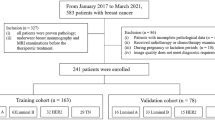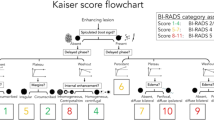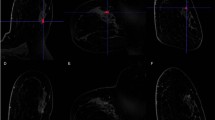Abstract
Purpose
To compare machine learning (ML) models with logistic regression model in order to identify the optimal factors associated with mammography-occult (i.e. false-negative mammographic findings) magnetic resonance imaging (MRI)-detected newly diagnosed breast cancer (BC).
Material and methods
The present single-centre retrospective study included consecutive women with BC who underwent mammography and MRI (no more than 45 days apart) for breast cancer between January 2018 and May 2023. Various ML algorithms and binary logistic regression analysis were utilized to extract features linked to mammography-occult BC. These features were subsequently employed to create different models. The predictive value of these models was assessed using receiver operating characteristic curve analysis.
Results
This study included 1957 malignant lesions from 1914 patients, with an average age of 51.64 ± 9.92 years and a range of 20–86 years. Among these lesions, there were 485 mammography-occult BCs. The optimal features of mammography-occult BC included calcification status, tumour size, mammographic density, age, lesion enhancement type on MRI, and histological type. Among the different ML models (ANN, L1-LR, RF, and SVM) and the LR-based combined model, the ANN model with RF features was found to be the optimal model. It demonstrated the best discriminative performance in predicting mammography false- negative findings, with an AUC of 0.912, an accuracy of 86.90%, a sensitivity of 85.85%, and a specificity of 84.18%.
Conclusion
Mammography-occult MRI-detected breast cancers have features that should be considered when performing breast MRI to improve the detection rate for breast cancer and aid in clinician management.








Similar content being viewed by others
References
Sung H, Ferlay J, Siegel RL, Laversanne M, Soerjomataram I, Jemal A, Bray F (2021) Global cancer statistics 2020: globocan estimates of incidence and mortality worldwide for 36 cancers in 185 countries. CA Cancer J Clin 71(3):209–249. https://doi.org/10.3322/caac.21660
Autier P, Boniol M (2018) Mammography screening: a major issue in medicine. Eur J Cancer 90:34–62. https://doi.org/10.1016/j.ejca.2017.11.002
Duffy SW, Tabar L, Yen AM, Dean PB, Smith RA, Jonsson H, Törnberg S, Chen SLS, Chiu SYH, Fann JCY, Ku MMS, Wu WYY, Hsu CY, Chen YC, Svane G, Azavedo E, Grundström H, Sundén P, Leifland K, Frodis E, Ramos J, Epstein B, Åkerlund A, Sundbom A, Bordás P, Wallin H, Starck L, Björkgren A, Carlson S, Fredriksson I, Ahlgren J, Öhman D, Holmberg L, Chen THH (2020) Mammography screening reduces rates of advanced and fatal breast cancers: results in 549,091 women. Cancer 126(13):2971–2979. https://doi.org/10.1002/cncr.32859
Massafra R, Latorre A, Fanizzi A, Bellottir R, Didonna V, Giotta F, Forgia DL, Nardone A, Pastena M, Ressa CM, Rinaldi L, Russo AOM, Tamborra P, Tangaro S, Zito A, Lorusso V (2021) A clinical decision support system for predicting invasive breast cancer recurrence preliminary results. Front Oncol. https://doi.org/10.3389/fonc.2021.576007
Elezaby M, Li G, Bhargavan-Chatfield M, Burnside ES, DeMartini WB (2018) ACR BI-RADS Assessment category 4 subdivisions in diagnostic mammography: utilization and outcomes in the national mammography database. Radiology 287(2):416–422. https://doi.org/10.1148/radiol.2017170770
Wecsler J, Jeong YJ, Raghavendra AS, Mack WJ, Tripathy D, Yamashita MW, Sheth PA, Larsen LH, Russell CA, MacDonald H, Sener SF, Lang JE (2020) Factors associated with MRI detection of occult lesions in newly diagnosed breast cancers. J Surg Oncol 121(4):589–598. https://doi.org/10.1002/jso.25855
Wang LJ, Chang LF, Luo R, Cui XE, Liu HH, Wu HT, Chen YH, Zhang YZ, Wu CQ, Li FZ, Liu H, Guan WB, Wang DB (2022) An artificial intelligence system using maximum intensity projection MR images facilitates classification of non-mass enhancement breast lesions. Eur Radiol 32:4857–4867. https://doi.org/10.1007/s00330-022-08553-5
Ma M, Liu R, Wen C, Xu W, Xu ZY, Wang S, Wu JF, Pan DR, Zheng BW, Qin GG, Chen WG (2022) Predicting the molecular subtype of breast cancer and identifying interpretable imaging features using machine learning algorithms. Eur Radiol 32(3):1652–1662. https://doi.org/10.1007/s00330-021-08271-4
Kim SY, Cho N, Shin SU, Lee HB, Han w, Park IA, Kwon BR, Kim SY, Lee SH, Chang JM, Moon WK (2018) Contrast-enhanced MRI after neoadjuvant chemotherapy of breast cancer: lesion-to-background parenchymal signal enhancement ratio for discriminating pathological complete response from minimal residual tumour. Eur Radiol 28:2986–2995. https://doi.org/10.1007/s00330-017-5251-8
Landis JR, Koch GG (1977) The measurement of observer agreement for categorical data. Biometrics 33(1):159–174
Choudhery S, Polley E, Conners AL (2020) Assessment of MRI-detected lesions on screening tomosynthesis in patients with newly diagnosed breast cancer. Clin Imaging 59(1):50–55. https://doi.org/10.1016/j.clinimag.2019.09.007
Bakker MF, de Lange SV, Pijnappel RM, Mann RM, Peeters PHM, Monninkhof EM, Emaus MJ, Loo CE, Bisschops RHC, Lobbes MBI, de Jong MDF, Duvivier KM, Veltman J, Karssemeijer N, de Koning HJ, van Diest PJ, Mali WPTM, van den Bosch MAAJ, Veldhuis WB, van Gils CH (2019) Supplemental MRI screening for women with extremely dense breast tissue. N Engl J Med 381(22):2091–2102. https://doi.org/10.1056/NEJMoa1903986
Anandarajah A, Chen YZ, Colditz GA, Hardi A, Stoll C, Jiang S (2022) Studies of parenchymal texture added to mammographic breast density and risk of breast cancer: a systematic review of the methods used in the literature. Breast Cancer Res 24(1):101–119. https://doi.org/10.1186/s13058-022-01600-5
Mann RM, Hooley R, Barr RG, Moy L (2020) Novel approaches to screening for breast cancer. Radiology 297(2):266–285. https://doi.org/10.1148/radiol.2020200172
Mann RM, Athanasiou A, Baltzer PAT, Camps-Herrero J, Clauser P, Fallenberg EM, Forrai G, Fuchsjäger MH, Helbich TH, Killburn-Toppin F, Lesaru M, Panizza P, Pediconi F, Pijnappel RM, Pinker K, Sardanelli F, Sella T, Thomassin-Naggara I, Zackrisson S, Gilbert FJ, Kuhl CK (2022) Breast cancer screening in women with extremely dense breasts recommendations of the european society of breast imaging (EUSOBI). Eur Radiol 32(6):4036–4045. https://doi.org/10.1007/s00330-022-08617-6
Aslan AA, Gültekin S (2023) Diagnostic performance of Kaiser score in patients with newly diagnosed breast cancer: factors associated with false-negative results. Eur J Radiol 164:110864. https://doi.org/10.1016/j.ejrad.2023.110864
Magni V, Interlenghi M, Cozzi A, Alì M, Salvatore C, Azzena AA, Capra D, Carriero S, Pepa GD, Fazzini D, Granata G, Monti CB, Muscogiuri G, Pellegrino G, Schiaffino S, Castiglioni I, Papa S, Sardanelli F (2022) Development and validation of an AI-driven mammographic breast density classification tool based on radiologist consensus. Radiol Artif Intell 4(2):e210199. https://doi.org/10.1148/ryai.210199
Freitas V, Li X, Amitai Y, Au F, Kulkarni S, Ghai S, Mulligan AM, Bromley M, Siepmann T (2022) Contralateral breast screening with preoperative MRI: long-term outcomes for newly diagnosed breast cancer. Radiology 304(2):297–307. https://doi.org/10.1148/radiol.212361
Lee SA, Lee Y, Ryu HS, Jang MJ, Moon WK, Moon HG, Lee SH (2022) Diffusion-weighted breast MRI in prediction of upstaging in women with biopsy-proven ductal carcinoma in situ. Radiology 305:307–316. https://doi.org/10.1148/radiol.213174
Hou R, Grimm LJ, Mazurowski MA, Marks JR, King LM, Maley CC, Lynch T, van Oirsouw M, Rogers K, Stone N, Wallis M, Teuwen J, Wesseling J, Hwang ES, Lo JY (2022) Prediction of upstaging in ductal carcinoma in situ based on mammographic radiomic features. Radiology 303(1):54–62. https://doi.org/10.1148/radiol.210407
Bragg A, Candelaria R, Adrada B, Huang M, Rauch G, Santiago L, Scoggins M, Whitman G (2021) Imaging of noncalcified ductal carcinoma in situ. J Clin Imaging Sci 11:34–40. https://doi.org/10.25259/JCIS_48_2021
Durand MA, Friedewald SM, Plecha DM, Copit DS, Conant EF (2021) False- negative rates of breast cancer screening with and without digital breast tomosynthesis. Radiology 298(2):296–305. https://doi.org/10.1148/radiol.20202028580-022-08617-6
Funding
Key research and development (R&D) project of the Ningxia Hui Autonomous Region. (NO. 2022BEG03166).
Author information
Authors and Affiliations
Corresponding author
Ethics declarations
Conflicts of interest
The authors declare that there is no conflict of interest.
Ethical approval
Ethical standards This article does not contain any studies with human participants or animals performed by any of the authors.
Human participants and/or animals
This study of deidentified data was approved by the institutional review board of General Hospital of Ningxia. Medical University.
Informed consent
Written informed consent was obtained from all individual participants in their participating site. The submission does not include images that may identify the person.
Guarantor
The scientific guarantor of this publication is Pro. Wei Yang.
Statistics and biometry
No complex statistical methods were necessary for this paper.
Additional information
Publisher's Note
Springer Nature remains neutral with regard to jurisdictional claims in published maps and institutional affiliations.
Rights and permissions
Springer Nature or its licensor (e.g. a society or other partner) holds exclusive rights to this article under a publishing agreement with the author(s) or other rightsholder(s); author self-archiving of the accepted manuscript version of this article is solely governed by the terms of such publishing agreement and applicable law.
About this article
Cite this article
Yang, W., Yang, Y., Zhang, N. et al. The features associated with mammography-occult MRI-detected newly diagnosed breast cancer analysed by comparing machine learning models with a logistic regression model. Radiol med (2024). https://doi.org/10.1007/s11547-024-01804-z
Received:
Accepted:
Published:
DOI: https://doi.org/10.1007/s11547-024-01804-z




